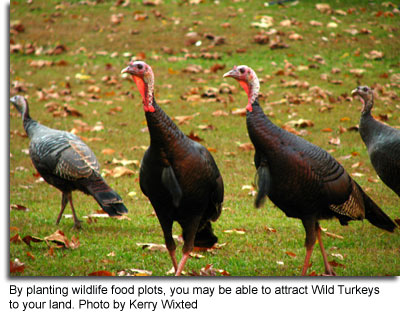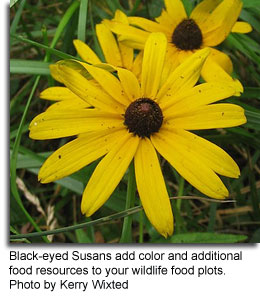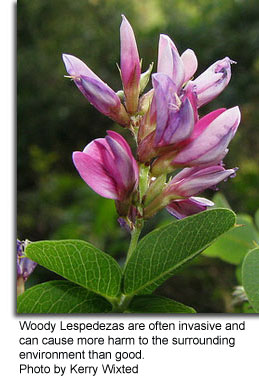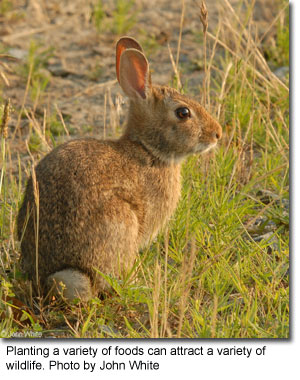Creating a Wild Backyard - Crops for Wildlife
If you plant crops for wildlife, then you are technically creating “wildlife food plots”. These plots not only provide food but also shelter and nesting sites for wildlife. The best plots contain a diversity of foods which accommodate the different needs of wildlife. Depending on where you live and what you plant, you could potentially attract deer, Wild Turkey, Bobwhite Quail, Mourning Doves, cottontail rabbits, waterfowl and/or grassland songbirds to your plot.

Getting Started
Before beginning a food plot adventure, it is best to assess your existing habitat. If your habitat contains a mix of mostly native plants, then consider keeping it. On the contrary, if your habitat is surrounded by corn and alfalfa fields, then planting the same crops won’t attract additional wildlife. If you are going to plant the area, then your next step would be to determine what you want to attract.
The three main types of plants in wildlife food plots include cool-season grasses, warm-season grasses and legumes. Cool season grasses are typically used for fall and winter food plots. These species include oats, wheat, rye and rye grass which provide high amounts of protein for wildlife. Cool season grasses are often preferred by deer. In contrast, warm season grasses are preferred by bobwhites, turkeys, rabbits, songbirds and others. To learn more about warm season grasses, then visit this Wild Acres page dedicated to Warm Season Grasses. The last category of wildlife food plot plants includes legumes. These plants belong to the bean family and have special relationships with soil bacteria that fixate nitrogen in the soil. Nitrogen is a key component for plant growth and one of the main ingredients of commercial fertilizers. In addition, legumes are low in fiber but high in energy and protein which makes them palatable to lots of wildlife species.
Where to Plant
Food plots can be located anywhere- from field edges to ditches to openings within a forested area. Interestingly enough, a food plot that has odd-shaped edges is actually more beneficial to wildlife than plots which are square or rectangular. This is because the irregular edges provide more cover from potential predators.
Ideally, food plots should be from 1-3 acres large in order to provide enough food and cover. However, plots can be smaller depending on the size of your area. The number of food plots you should provide also depends on the size of your area as well as the type of habitat surrounding your property. If the area surrounding your food plot is high quality forest, then you generally don’t need to provide multiple food plots. One guideline is to plant 1 acre food plots for every 40 acres of land. Rotating food plots every few years can also benefit wildlife, and if you have multiple plots on your land, then consider offering different plantings in each.
 Suggested Mixes
Suggested Mixes
The following information contains some very general information on suggested mixes. It should be noted that if you are planning on planting perennial species, then they may not flower or fruit the first year.
Dry/Upland Soils (Perennial mix providing food and shelter)
Wet/Lowland Soils (perennial mix providing food and shelter)
A suggested mixture of annual food crops for upland areas is:
Other suggested plants: alfalfa, annual rye, big bluestem, black oil sunflower, brassicas (rape and turnips), corn, grain sorghum, Indian grass, partridge peas, purple coneflower and sunflower mixes.
The best plants to add to your plot are native plants as these species have adapted to Maryland soils over time. Many native plants also attract native pollinators which provide food for insect-loving predators like grassland songbirds.
When selecting wildlife food plot mixes and seeds be sure to avoid plants which are invasive as they can cause more harm than good. Invasive species typically planted for food plots include woody lespedezas (Lespedeza bicolorand
L. cuneata) as well as crown vetch (Vicia spp.).

How to Plant a Food Plot
- Have a soil test done on the site to determine the soil type and structure, soil pH, and any plant nutrients that may be missing. Contact the U.S. Department of Agriculture's Soil Conservation Service office in your county for more information. Nutrients and other requirements provided by the soil differ for each plant species. The U.S.D.A. Cooperative Extension Service can assist you in choosing the right crops/nutrient/soil combination for your area and your needs.
- Prepare the soil by plowing or discing the area to be planted
- Seeds can be planted by spreading and raking them in or by drilling them into the seedbed.
Common Food Plot Mistakes

Invite Wildlife to Your Backyard!
For more information, please contact:
Maryland Department of Natural Resources
Wildlife and Heritage Service
Tawes State Office Building, E-1
Annapolis MD 21401
410-260-8540
Toll-free in Maryland: 1-877-620-8DNR
[email protected]
Acknowledgements: